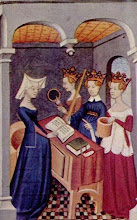
At the Dutch Royal Institute For Cultural Heritage they have a set of tapestries that include pictures of period Rom interacting with the locals from about 1500. Down at the very bottom left of the tapestry called "The Fair" there is a female figure who I think might be a dancer. She's wearing the ever popular white turban and a v-necked kirtle, similar in shape to the Spanish vertigale gowns you can see on the ladies in waiting here. This picture is by a Spanish painter Pedro Garcia de Benabarre and is dated between 1470 and 1480.

It is possible that the small female Rom is actually supposed to be a child. I've read a few commentaries on how the locals in an area often despised the Rom for the tatters they dressed their children in and the figure is smaller then the nobles. However, if the figure is only smaller because they were still working out perspective for use in tapestry, this may be one of the links I've been looking for.
It's exceptionally hard to document information on a physical art form such as dance or acting. We normally have to rely on written records from the past or clues in the play we perform to get our cues. However, even today the Rom are not known for writing things down. Most of the historical records I've found for them come from an outside source documenting their arrival or passage. That's why this tapestry may be so important to me. I'm looking for the earliest documentable "Gypsy Dancer" and this is the first one I've seen a picture of so far.
Why do I think she's a dancer? The belt around her waist is very hard to make out, but I suspect it's a set of the large acorn-shaped folly bells like the ones Cynthia du Pré Argent talks about for her
houppelande. The other forward lady, down right of the tapestry, looks like she's holding one in her hand as well. Then, around her left wrist, there's a length of ribbon floating out from her body. Her arms appear to be moving, spread out away from her body and her leg is pretty easy to see as well. In fact, I don't see a long chemise to cover that leg, just a shirt under the gown. Maybe the chemise had a slit in it? Maybe I can't see a detail on-line that's visible in a different picture? I need more evidence!
I'd like to try and find a few more pictures of dancers from about 1500 and compare them. If I can find them I may be able to start reconstructing actual dance steps as well as period-correct costuming. This could be really cool.

No comments:
Post a Comment